The Effect of Dielectric Barrier Discharge Plasma Gas and Plasma-Activated Water on the Physicochemical Changes in Button Mushrooms (Agaricus bisporus)
Abstract
1. Introduction
2. Materials and Methods
2.1. The Mushroom Samples and Storage Conditions
2.2. The Plasma Equipment and Plasma-Activated Water Generation
2.3. Sample Treatments
2.4. The pH and Temperature Determination of Plasma-Activated Water
2.5. Color Evaluation
2.6. Textural Evaluation
2.7. pH Evaluation
2.8. Sensory Evaluation
2.9. Weight Loss and Water Activity Determination
2.10. PPO Activity Assay
2.11. Statistical Analysis
3. Results and Discussion
3.1. pH and Temperature Determination of Plasma-Activated Water
3.2. Physicochemical Properties of the Mushrooms
3.2.1. Cap Browning and Appearance Changes
3.2.2. The Effect of Plasma Treatment on Hardness and Weight Loss
3.2.3. The Effect of Plasma Treatment on pH
3.2.4. The Sensory Evaluation and Water Activity of the Mushrooms
3.2.5. PPO Activity Assay
4. Conclusions
Author Contributions
Funding
Acknowledgments
Conflicts of Interest
References
- Hammond, J.; Nichols, R. Changes in respiration and soluble carbohydrates during the post-harvest storage of mushroom (Agaricus bisporus). J. Sci. Food Agric. 1975, 26, 835–842. [Google Scholar] [CrossRef]
- Oke, F.; Aslim, B. Protective effect of two edible mushrooms against oxidative cell damage and their phenolic composition. Food Chem. 2011, 128, 613–619. [Google Scholar] [CrossRef]
- Xue, Y.; Xie, J.; Xu, X.S.; Yong, L.; Hu, B.; Liang, J.; Qing, L.S. UPLC-QqQ/MS combined with similarity assessment of 17 nucleic acid constituents in 147 edible fungi from Sichuan Basin, China. Food Res. Int. 2019, 120, 577–585. [Google Scholar] [CrossRef] [PubMed]
- Belay, Z.; Caleb, O.; Opara, U. Enzyme kinetics model-ling approach to evaluate the impact of high CO2 and super-atmo pheric O2 concentrations on respiration rate of pomegranate arils. J. Food 2017, 15, 608–616. [Google Scholar]
- Lei, J.; Li, B.; Zhang, N.; Yan, R.; Guan, W.; Brennan, C.S.; Gao, H.; Peng, B. Effects of UV-C treatment on browning and the expression of polyphenol oxidase (PPO) genes in different tissues of Agaricus bisporus during cold storage. Postharvest Biol. Technol. 2018, 139, 99–105. [Google Scholar] [CrossRef]
- Taranto, F.; Pasqualone, A.; Mangini, G.; Tripodi, P.; Miazzi, M.M.; Pavan, S.; Montemurro, C. Polyphenol oxidases in crops: Biochemical, physiological and genetic aspects. Int. J. Mol. Sci. 2017, 18, 377. [Google Scholar] [CrossRef]
- Ozturk, H.M.; Ozturk, H.K.; Koçar, G. Microbial analysis of meatballs cooled with vacuum and conventional cooling. J. Food Sci. Technol. 2017, 54, 2825–2832. [Google Scholar] [CrossRef]
- Miller, F.A.; Silva, C.L.M.; Brandão, T.R.S. A review on ozone-based treatments for fruit and vegetables preservation. Food Eng. Rev. 2013, 5, 77–106. [Google Scholar] [CrossRef]
- Oliveira, M.; Abadias, M.; Usall, J.; Torres, R.; Teixidó, N.; Viñas, I. Application of modified atmosphere packaging as a safety approach to fresh-cut fruits and vegetables—A review. Trends Food Sci. Technol. 2015, 46, 13–26. [Google Scholar] [CrossRef]
- Beaulieu, M.; D’Aprano, M.B.G.; Lacroix, M. Dose rate effect of γ irradiation on phenolic compounds, polyphenol oxidase, and browning of mushrooms (Agaricus bisporus). J. Agric. Food Chem. 1999, 47, 2537–2543. [Google Scholar] [CrossRef]
- Li, B.; Ding, Y.; Tang, X.; Wang, G.; Wu, S.; Li, X.; Huang, X.; Qu, T.; Chen, J.; Tang, X. Effect of L-arginine on maintaining storage quality of the white button mushroom (Agaricus bisporus). Food Bioprocess Technol. 2019, 12, 563–574. [Google Scholar] [CrossRef]
- Rico, D.; Martín-Diana, A.B.; Barat, J.M.; Barry-Ryan, C. Extending and measuring the quality of fresh-cut fruit and vegetables: A review. Trends Food Sci. Technol. 2007, 18, 373–386. [Google Scholar] [CrossRef]
- Zhang, K.; Pu, Y.Y.; Sun, D.W. Recent advances in quality preservation of postharvest mushrooms (Agaricus bisporus): A re-view. Trends Food Sci. Technol. 2018, 78, 72–82. [Google Scholar] [CrossRef]
- Gavahian, M.; Sheu, F.-H.; Tsai, M.J.; Chu, Y.H. The effects of dielectric barrier discharge plasma gas and plasma-activated water on texture, color, and bacterial characteristics of shiitake mushroom. J. Food Process. Preserv. 2020, 44, e14316. [Google Scholar] [CrossRef]
- Potluri, S.; Sangeetha, K.; Santhosh, R.; Nivas, G.; Mahendran, R. Effect of low-pressure plasma on bamboo rice and its flour. J. Food Process. Preserv. 2018, 42, e13846. [Google Scholar] [CrossRef]
- Xu, Y.; Tian, Y.; Ma, R.; Liu, Q.; Zhang, J. Effect of plasma activated water on the postharvest quality of button mushrooms, Agaricus bisporus. Food Chem. 2016, 197, 436–444. [Google Scholar] [CrossRef] [PubMed]
- Jiang, T. Effect of alginate coating on physicochemical and sensory qualities of button mushrooms (Agaricus bisporus) under a high oxygen modified atmosphere. Postharvest Biol. Technol. 2013, 76, 91–97. [Google Scholar] [CrossRef]
- Gao, M.; Feng, L.; Jiang, T. Browning inhibition and quality preservation of button mushroom (Agaricus bisporus) by essential oils fumigation treatment. Food Chem. 2014, 149, 107–113. [Google Scholar] [CrossRef]
- Nasiri, M.; Barzegar, M.; Sahari, M.A.; Niakousari, M. Tragacanth gum containing Zataria multiflora Boiss. essential oil as a natural preservative for storage of button mushrooms (Agaricus bisporus). Food Hydrocoll. 2017, 72, 202–209. [Google Scholar] [CrossRef]
- Dedeoglu, N.; Guler, O.O. Differential in vitro inhibition of polyphenoloxidase from a wild edible mushroom Lactarius salmonicolor. J. Enzym. Inhib. Med. Chem. 2009, 24, 464–470. [Google Scholar] [CrossRef]
- Illera, A.E.; Chaple, S.; Sanz, M.T.; Ng, S.; Lu, P.; Jones, J.; Carey, E.; Bourke, P. Effect of cold plasma on polyphenol oxidase inactivation in cloudy apple juice and on the quality parameters of the juice during storage. Food Chem. X 2019, 3, 100049. [Google Scholar] [CrossRef] [PubMed]
- Ma, R.; Yu, S.; Tian, Y.; Wang, K.; Sun, C.; Li, X.; Zhang, J.; Chen, K.; Fang, J. Effect of non-thermal plasma-activated water on fruit decay and quality in postharvest Chinese bayberries. Food Bioprocess Technol. 2016, 9, 1825–1834. [Google Scholar] [CrossRef]
- Ma, R.; Wang, G.; Tian, Y.; Wang, K.; Zhang, J.; Fang, J. Non-thermal plasma-activated water inactivation of food-borne pathogen on fresh produce. J. Hazard. Mater. 2015, 300, 643–651. [Google Scholar] [CrossRef] [PubMed]
- Wu, H.; Sun, P.; Feng, H.; Zhou, H.; Wang, R.; Liang, Y.; Lu, J.; Zhu, W.; Zhang, J.; Fang, J. Reactive oxygen species in a non-thermal plasma microjet and water system: Generation, conversion, and contributions to bacteria inactivation—An analysis by electron spin resonance spectroscopy. Plasma Process. Polym. 2012, 9, 417–424. [Google Scholar] [CrossRef]
- Rodacka, A.; Gerszon, J.; Puchala, M.; Bartosz, G. Radiation-induced inactivation of enzymes–Molecular mechanism based on inactivation of dehydrogenases. Radiat. Phys. Chem. 2016, 128, 112–117. [Google Scholar] [CrossRef]
- Cooper, M.; Fridman, G.; Fridman, A.; Joshi, S.G. Biological responses of Bacillus stratosphericus to floating electrode-dielectric barrier discharge plasma treatment. J. Appl. Microbiol. 2010, 109, 2039–2048. [Google Scholar] [CrossRef]
- Narvaiz, P. Some physicochemical measurements on mushrooms (Agaricus campestris) irradiated to extend shelf-life. LWT—Food Sci. Technol. 1994, 27, 7–10. [Google Scholar] [CrossRef]
- Zivanovic, S.; Busher, R.W.; Kim, K.S. Textural changes in mushrooms (Agaricus bisporus) associated with tissue ultrastructure and composition. J. Food Sci. 2000, 65, 1404–1408. [Google Scholar] [CrossRef]
- Akbarirad, H.; Kazemeini, S.; Shariati, M.A. Deterioration and some of applied preservation techniques for common mushrooms (Agaricus bisporus, followed by Lentinus edodes, pleurotus spp.). J. Microbiol. Biotechnol. Food Sci. 2013, 2, 2–6. [Google Scholar]
- Misra, N.N.; Keener, K.M.; Bourke, P.; Mosnier, J.P.; Cullen, P.J. In-package atmospheric pressure cold plasma treatment of cherry tomatoes. J. Biosci. Bioeng. 2014, 118, 177–182. [Google Scholar] [CrossRef]
- Braaksma, A.; Schaap, D.J.; Schipper, C.M.A. Time of harvest determines the postharvest quality of the common mushroom Agaricus bisporus. Postharvest Biol. Technol. 1999, 16, 195–198. [Google Scholar] [CrossRef]
- Surowsky, B.; Fischer, A.; Schlueter, O.; Knorr, D. Cold plasma effects on enzyme activity in a model food system. Innov. Food Sci. Emerg. Technol. 2013, 19, 146–152. [Google Scholar] [CrossRef]
- Pankaj, S.K.; Misra, N.N.; Cullen, P.J. Kinetics of tomato peroxidase inactivation by atmospheric pressure cold plasma based on dielectric barrier discharge. Innov. Food Sci. Emerg. Technol. 2013, 19, 153–157. [Google Scholar] [CrossRef]

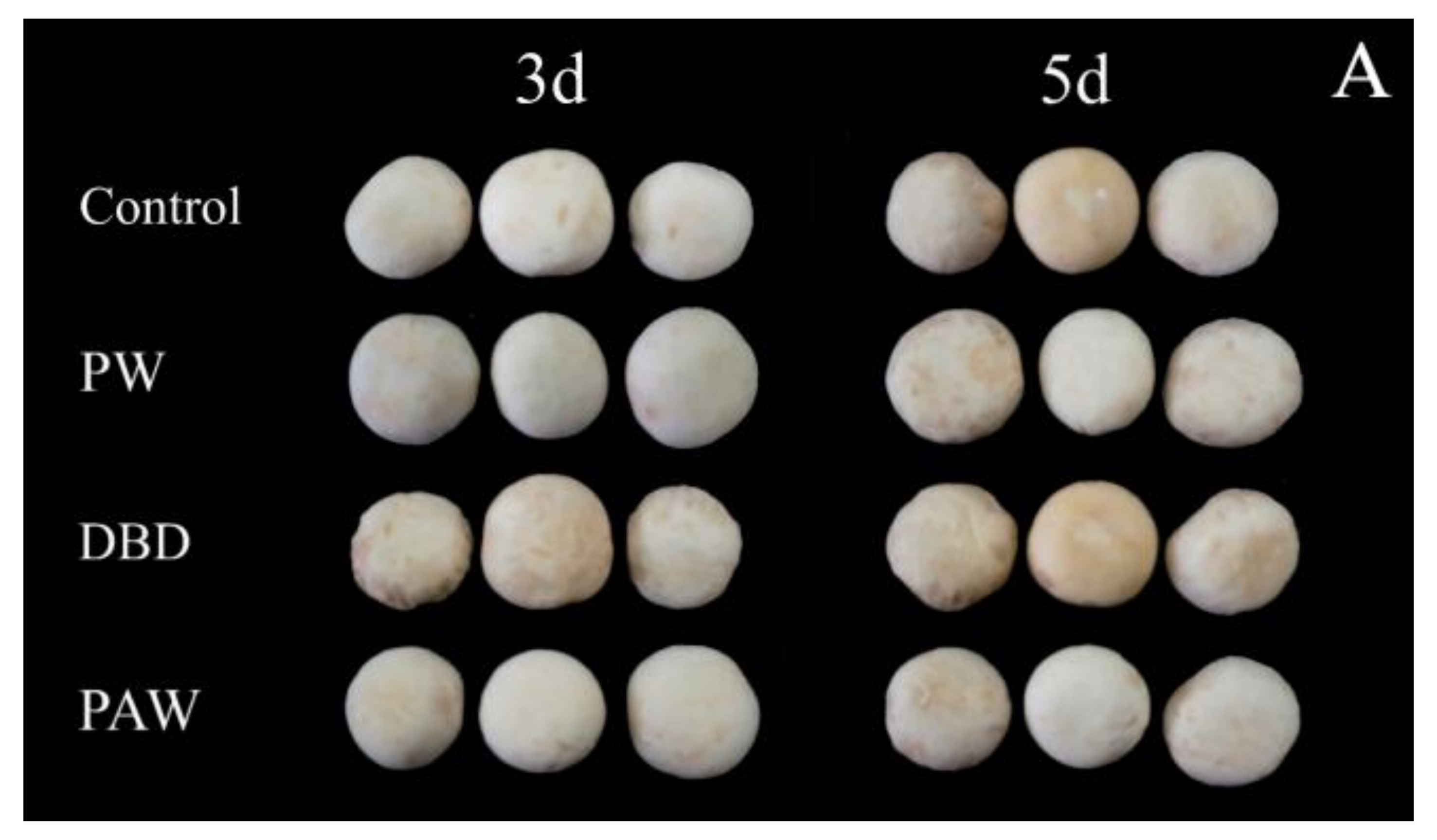
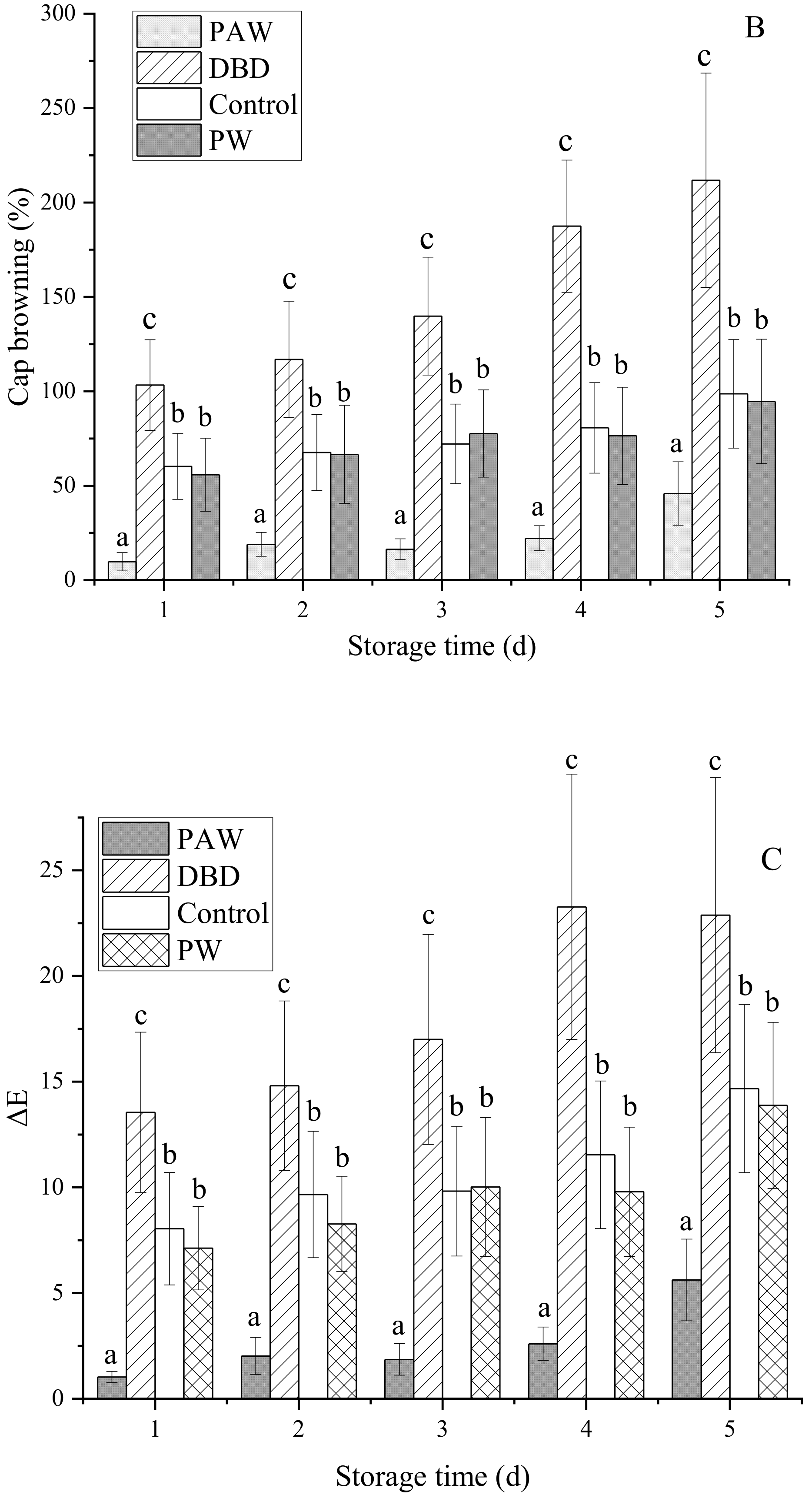
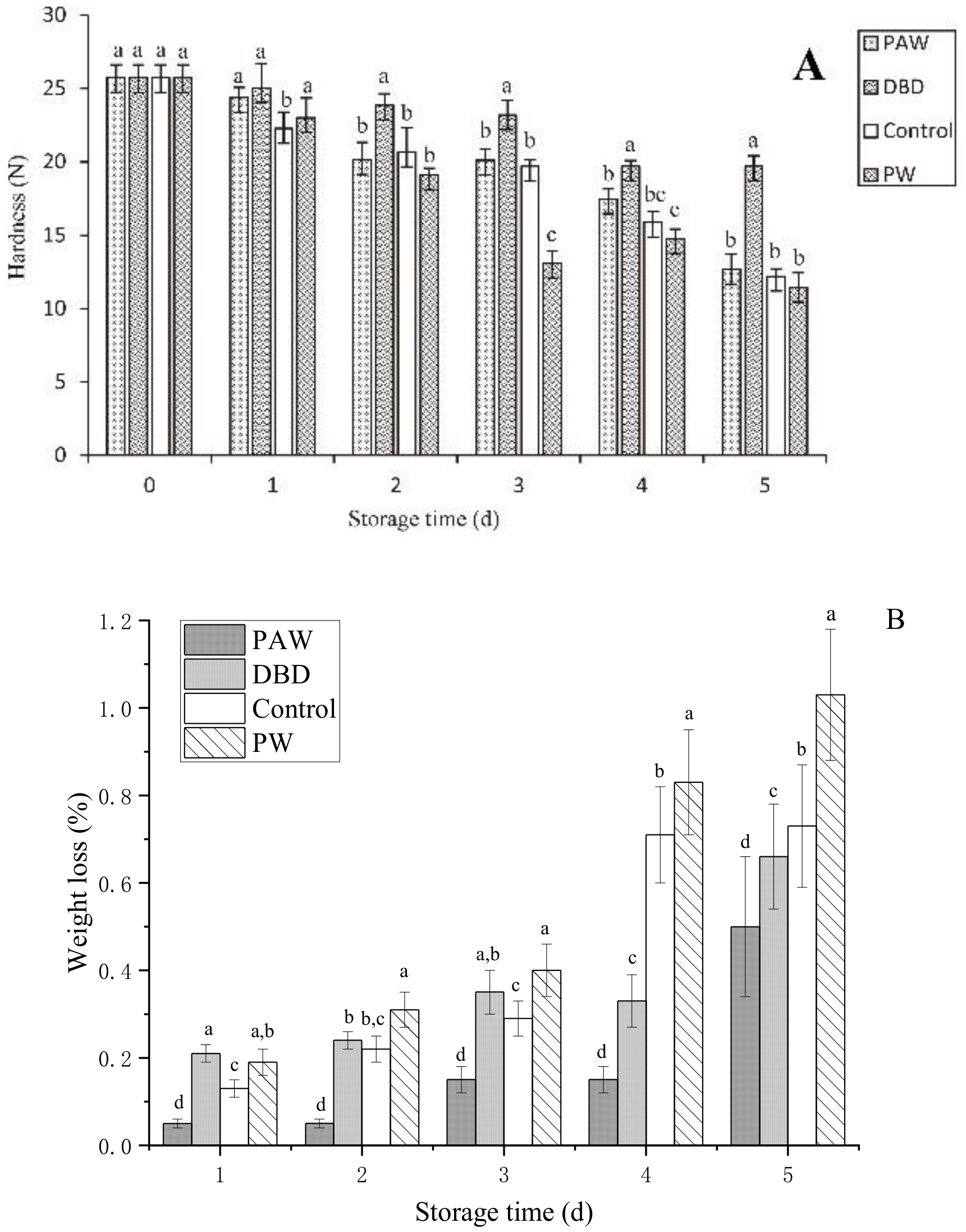
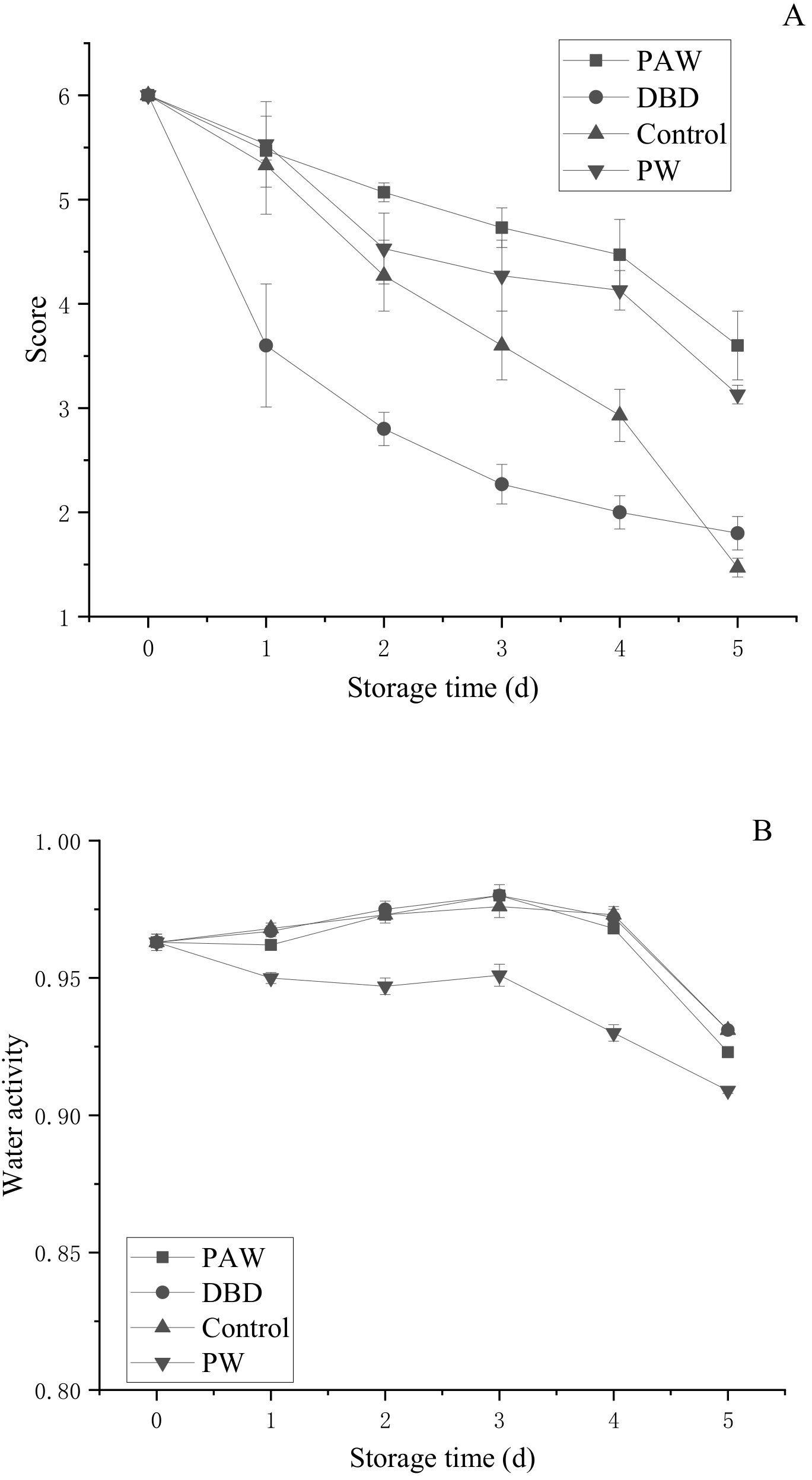
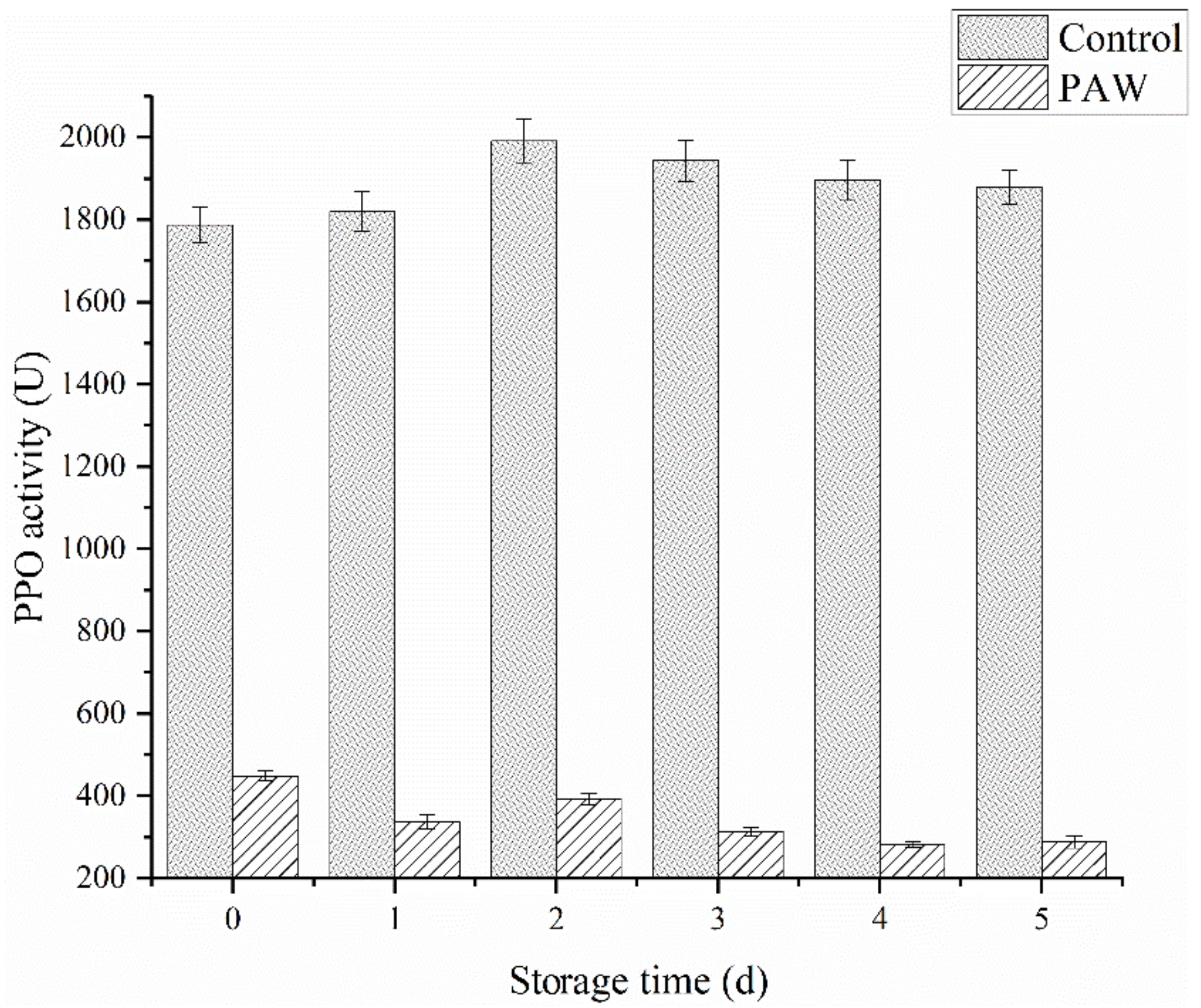
| Level | Color | Umbrella Opening Degree (%) | Wilting Degree (%) | Score |
|---|---|---|---|---|
| 1 | White | <3 | <5 | 6 |
| 2 | Slight color change | 3–10 | 5–10 | 5 |
| 3 | Color deepening | 10–20 | 10–25 | 4 |
| 4 | Slight browning | 20–50 | 25–50 | 3 |
| 5 | Brown | 50–80 | 50–80 | 2 |
| 6 | Dark brown | >80 | >80 | 1 |
| Day | DBD | PAW | PW | Control |
|---|---|---|---|---|
| 0 | 6.14 ± 0.04 | 6.14 ± 0.02 | 6.14 ± 0.05 | 6.14 ± 0.02 |
| 1 | 6.07 ± 0.02 | 6.02 ± 0.01 | 6.06 ± 0.03 | 6.08 ± 0.06 |
| 2 | 6.02 ± 0.06 | 6.01 ± 0.01 | 5.95 ± 0.02 | 5.98 ± 0.04 |
| 3 | 6.04 ± 0.04 | 6.01 ± 0.04 | 6.06 ± 0.01 | 6.07 ± 0.04 |
| 4 | 6.14 ± 0.01 | 6.08 ± 0.02 | 6.02 ± 0.04 | 5.99 ± 0.03 |
| 5 | 6.18 ± 0.02 | 6.08 ± 0.02 | 6.14 ± 0.03 | 6.11 ± 0.01 |
Publisher’s Note: MDPI stays neutral with regard to jurisdictional claims in published maps and institutional affiliations. |
© 2022 by the authors. Licensee MDPI, Basel, Switzerland. This article is an open access article distributed under the terms and conditions of the Creative Commons Attribution (CC BY) license (https://creativecommons.org/licenses/by/4.0/).
Share and Cite
Zheng, Y.; Zhu, Y.; Zheng, Y.; Hu, J.; Chen, J.; Deng, S. The Effect of Dielectric Barrier Discharge Plasma Gas and Plasma-Activated Water on the Physicochemical Changes in Button Mushrooms (Agaricus bisporus). Foods 2022, 11, 3504. https://doi.org/10.3390/foods11213504
Zheng Y, Zhu Y, Zheng Y, Hu J, Chen J, Deng S. The Effect of Dielectric Barrier Discharge Plasma Gas and Plasma-Activated Water on the Physicochemical Changes in Button Mushrooms (Agaricus bisporus). Foods. 2022; 11(21):3504. https://doi.org/10.3390/foods11213504
Chicago/Turabian StyleZheng, Yan, Yifan Zhu, Yanhong Zheng, Jiajie Hu, Jing Chen, and Shanggui Deng. 2022. "The Effect of Dielectric Barrier Discharge Plasma Gas and Plasma-Activated Water on the Physicochemical Changes in Button Mushrooms (Agaricus bisporus)" Foods 11, no. 21: 3504. https://doi.org/10.3390/foods11213504
APA StyleZheng, Y., Zhu, Y., Zheng, Y., Hu, J., Chen, J., & Deng, S. (2022). The Effect of Dielectric Barrier Discharge Plasma Gas and Plasma-Activated Water on the Physicochemical Changes in Button Mushrooms (Agaricus bisporus). Foods, 11(21), 3504. https://doi.org/10.3390/foods11213504






